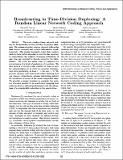Broadcasting in Time-Division Duplexing: A Random Linear Network Coding Approach
Author(s)
Lucani, Daniel Enrique; Medard, Muriel; Stojanovic, Milica
DownloadLucani-2009-Broadcasting in Time-Division Duplexing A Random Linear Network Coding Approach.pdf (4.113Mb)
PUBLISHER_POLICY
Publisher Policy
Article is made available in accordance with the publisher's policy and may be subject to US copyright law. Please refer to the publisher's site for terms of use.
Terms of use
Metadata
Show full item recordAbstract
We study random linear network coding for broadcasting in time division duplexing channels. We assume a packet erasure channel with nodes that cannot transmit and receive information simultaneously. The sender transmits coded data packets back-to-back before stopping to wait for the receivers to acknowledge the number of degrees of freedom, if any, that are required to decode correctly the information. We study the mean time to complete the transmission of a block of packets to all receivers. We also present a bound on the number of stops to wait for acknowledgement in order to complete transmission with probability at least 1 - epsiv, for any epsiv > 0. We present analysis and numerical results showing that our scheme outperforms optimal scheduling policies for broadcast, in terms of the mean completion time. We provide a simple heuristic to compute the number of coded packets to be sent before stopping that achieves close to optimal performance with the advantage of a considerable reduction in the search time.
Date issued
2009-08Department
Massachusetts Institute of Technology. Department of Electrical Engineering and Computer ScienceJournal
Workshop on Network Coding, Theory, and Applications, 2009. NetCod '09.
Publisher
Institute of Electrical and Electronics Engineers
Citation
Lucani, D.E., M. Medard, and M. Stojanovic. “Broadcasting in time-division duplexing: A random linear network coding approach.” Network Coding, Theory, and Applications, 2009. NetCod '09. Workshop on. 2009. 62-67. © Copyright 2010 IEEE
Version: Final published version
Other identifiers
INSPEC Accession Number: 10813713
ISBN
978-1-4244-4723-7